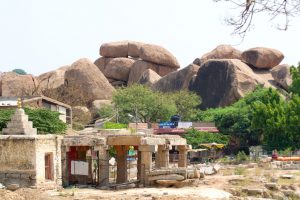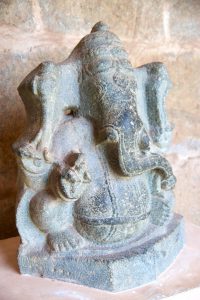As I woke up just before the alarm there
was no rush and after a cup of coffee my Uber drive to the railway
station picked me up. Once at the railway station I got back into the
travel mood and found my way to the platform no.5 where I boarded the
super fast express to Hospet Junction. Yeah, super fast… Just under
ten hours for 406 kilometres. I managed to find my reserved first class
seat for the journey and was ready for another day of train fun in
India, all from my 2 person sleeper cabin, and being taken care of
something to eat and drink every now and then (just ring the bell when
you need anything Sir). I even managed to sleep a couple of hours before
I put on some music and my eyes admired the dry landscape passing by.
What else could one wish for, life was good once again…

Once we finally arrived in
Hampi I got a Tuk Tuk towards my hotel. It was massive but looked good
and I got a nice room in “the old wing”. After that I went to the
restaurant for a well deserved drink and dinner. Although it had been a
lazy day I could feel the kilometers travelled. The old monk gin tasted
perfect as usual, as was my tandoori chicken salad…
Back in my room I tried to
go to sleep but noticed I was placed in a smokers room so I got dressed
again, returned to the reception and asked for a different, smoke free
room. Thousands of apologies and an upgrade later I had moved to a smoke
free room and was finally able to sleep.
And I slept well that
night, so good I even overslept. I had arranged to meet Kai, my Tuk Tuk
driver at 9:30 which I did manage to make in time but then there still
was breakfast to be enjoyed…
So about half an hour
later than originally planned I hit the road. Immediately I noticed I
was in a much more rural area than before. The magnificent ruins of
Hampi were dotted in an unearthly landscape that have captivated
travelers for centuries. Heaps of giant boulders perch precariously over
kilometers of undulating terrain, their rusty hues offset by jade-
green palm groves, banana plantations and paddy fields.
From Hosapete it took
about a 30 minute drive to reach this World Heritage Site, a journey
that did not bore for a single minute as there was so much to be seen.
Fully loaded ox carts were driven over the roads and villagers were busy
with their daily thing, all in a much lower pace than in the city.
Our first stop at the
Hampi bazaar was the Virupaksha Temple, one of the city’s oldest
structures, and Hampi’s only remaining working temple. The main gopuram,
almost 50m high, was built in 1442, with a smaller one added in 1510.
The main shrine is dedicated to Virupaksha, a reincarnation of Shiva. In
front of the temple work was going on at a massive wooden chariot, used
during ceremonies.
It was terribly warm that
day, over 35 degrees and I had to stop a couple of times to catch my
breath and recover from my diziness. The temple was absolutely divine
though and I admired the plenty of small shrines where worshippers were
praying to their deities.
At the east end of Hampi
Bazaar we went two the second highlight of the day, a Nandi statue,
around which stand some of the colonnaded blocks of the ancient
marketplace. The Nandi, in the form of a bull is Shiva’s vehicle and was
located in a temple at the foot of a hill. A herd of goats past by
whilst I was relaxing a bit (and escaping the heat) the goat herder
asked me to hold a goat so he could remove a thorn from it’s claw. Great
to make myself useful.
After a short break we
continued to the south. Overlooking Virupaksha Temple, Hemakuta Hill has
a scattering of early ruins, including monolithic sculptures of
Narasimha (Vishnu in his Mansslion incarnation) and an immense status of
Ganesha. Another gorgeous sighting of remainder from a land forgotten
in time…
Next was the Krishna
temple. Built in 1513, the Krishna Temple is fronted by an apsara and 10
incarnations of Vishnu. There were stunning carvings to be admired and
beautifully carved pillars were still supporting the roof built
centuries ago… I loved the atmosphere in here and the rays of light
penetrating from holes in the roof. At times I could smell bat poo
however I could not see any bats, they must have been hiding in the
darker areas of the temple complex.
There was so much to
explore so we headed on to the Lakshmi Narasimha Temple. This is the
largest statue in Hampi. Narasimha is sitting on the coil of a giant
seven-headed snake called Sesha. The heads of the snake acts as the hood
above his head. The god sits in a cross-legged Yoga position with a
belt supporting the knees.
Stunning in one word, next
to it was Badavilngha temple witch I also payed a short visit but my
eyes were caught by a stall at the side of the street which sold fresh
coconuts. Something I had really deserved at this strenuous day.
Our next stop was not far
away. For some curious reasons, this temple dedicated to Lord Siva was
built many meters below the ground level. For this reason, almost all
the time the sanctum and the core parts of the temple are under water,
restricting entry to the inner areas. But now it was easy to access
stepping down a set of steps that led towards the sanctum.
We headed on to the
Hazarama temple. It featured exquisite carvings that depict scenes from
the Ramayana, and polished black granite pillars. Another stunning
temple but by now I was getting really tired and once again my dizziness
was playing up. Fortunately there was only one place that we were
supposed to visit today.
The queens bath looked deceptively plain on the outside but was amazing within, with its Indo-Islamic architecture.
Somehow I was glad the day
was over as I was exhausted by now. Kai, my driver, brought me to a
nice garden restaurant for lunch where I enjoyed, part of, a tali, which
was far to big for one person…
Back at the hotel I had a
nice and cooling swim at the blue lagoon pool, as well as a short nap
before dinner. What a wonderful day it had been.
The next day can go into
the books as another lazy day. I had a sleep in until after eleven and
after my shower went for lunch straight away. Somehow I still felt
exhausted so I returned to my room and slept a couple of hours more.
Then I updated my journal beside the pool and listened to some music. I
enjoyed a small dinner and in spite of having done nothing at all that
day went to bed to early.
The impact of this epic
journey is starting to ask it’s toll. I can only say I am enjoying every
single moment of it but by now I realize how extremely tiring it is. I
start looking forward to going to Little Cove and relax, do some yoga
and recover from this fabulous time. But it is not time for that yet…
Next morning Kai was
waiting for me again and we headed off for our short journey to Hampi.
We passed the Talarighata gate, once the main entry point to the city
from the riverside.
But the real first point
of visit of the day was the indisputable highlight of the Hampi ruins,
the 16th-century Vittala Temple. It stands amid the boulders 2km from
Hampi Bazaar and as no Tuk Tuks were allowed in it’s vicinity I either
had the choice to walk the last couple of hundred meter or take an
extended electric golf cart for 20Rp. for the return journey. Being a
lazy butt and with the temperatures were already being quite high I
choose for the latter.
Work on the temple
possibly started during the reign of Krishnadevaraya (r 1509–29). It was
never finished or consecrated, yet the temple’s incredible sculptural
work remains the pinnacle of Vijayanagar art.
The sanctum itself was out
of bounds due to reconstruction but still I could admire the absolutely
stunning carving, although two policewomen who had nothing better to do
than to relax in the sun warned me not to come too close, although I
was clearly behind the warning shields.
The ornate stone chariot
that stands in the courtyard is the temple’s showpiece and represents
Vishnu’s vehicle with an image of Garuda within. Its wheels were once
capable of turning, but that is now long time ago.
On the left and right upon
entry I could see the marriage hall and prayer hall. After hanging
around for a while it was rather clear to me why this temple was the
highlight of the ruins, it carvings were in one word stunning.
Next we went to a museum
which was ok but would have been far more interesting if someone could
have been bothered to turn on the light.. a huge maquette in the central
courtyard however gave a good impression of the layout of Hampi, then
known as Vijayanagar, in it’s most glorious time.
By the 16th century it was
a thriving metropolis of about 500,000 people, its busy bazaars
dabbling in international commerce, brimming with precious stones and
merchants from faraway lands. All this, however, ended in a stroke in
1565, when a confederacy of Deccan sultanates razed Vijayanagar to the
ground, striking it a death blow from which it never recovered.
Our final visit for today
was the Royal Centre. There I visited the Lotus Mahal, the Ranga temple
and finally the elephant’s stables. I also had a good view ver a large
watchtower in one of the corners of the compound, unfortunately there
was no way to climb it as the view over the Royal Centre would have
undoubtedly magnificent.
The heat was almost
unbearable although Kai told me the year before had been much warmer.
Glad it was a relatively cool year. We had lunch at the famous Mango
Tree restaurant which already belongs to the same family for three
generations. And then it was time to return to my hotel for a refreshing
swim.
The biggest surprise of
the day was when I noticed the hotel staff was running through the
corridors of the hotel whilst shooting an air gun. It turned out they
were chasing a monkey. I could not stop laughing and decided it was time
to head down to the restaurant, grab a beer and work on my journal. It
had been another fabulous day…
The morning after was a
slow start as I had agreed to meet Kai at ten o’clock. I was picked up
however by another driver, Ganesh, who had told me he was sent by Kai
(also known as coconut) as he had some problems with his Tuk Tuk.
Fortunately Ganesh was
aware about the itinerary so I did not need to be worried to miss out on
things or see places double. Our first stop was Anjana hill where
Hanoman’s temple was built at the place of his birth.
It was already very warm
which did not make it easy to climb the 575 steps to the top.
Fortunately the majority of the steps was covered by a steel
construction so I was at least a bit sheltered from the sun.
The temple itself was not
worth the climb but the view made up for everything. It was the first
time I had a brilliant overview of the Hampi valley and it’s ruins. The
boulders in the rugged terrain gave it an almost unearthly appearance.
Monkeys were playing at the platform and chasing each other, another
great add on to the experience.
Going down was a lot
easier than coming up though I still had a couple of breaks to catch my
breath. Ganesh had parked his Tuk Tuk in the shade and was already
waiting for me.
Our next stop was the
biggest lake in the valley. Surrounded by big boulders it appeared to
be just a dead body of water although I saw some men fishing at it’s
shoreline. Swimming was not allowed as crocodiles were supposed to be in
the water, something I strongly doubted…
We returned to Virupapur
Gaddi, across the river from Hampi Bazaar, once it was famous for it’s
rural tranquility but now it was more like a ghetto of cheap guest
houses and hangout places for backpackers. Food was excellent I must
admit but Ganesh had a break in mind that was long than I expected. I
went for a short walk towards the river and was glad I had not chosen
Hampi itself as my place of residence, I would not have liked it…
Finally we got on the road
again towards another temple that was built in front of a small
artificial pond. The temple itself was very basic but I was invited to
go inside and the Brahman performed a small ritual for me which, as a
respectful tourist, underwent with patience. A big red tika on my
forehead reminded me the rest of the day of the ceremony.
Next stop was the Durga
temple, a big complex with several Sadhu’s taking care of it, all in an
extremely relaxed pace. A tree in front of the temple was covered in
colorful textiles that were filled with offerings. Next to it was a big
food hall, with it currently not being in use several people were
sleeping in the protective shade it provided.
Behind the temple a
footpath lead to another small temple dedicated to Ganesha, and even
further, deep in between the rocks was the so called cobra temple. From
where I was standing I could see the temple we previously visited and I
had a good view over the valley with the Hanuman temple in the distance.
Another stop in a small
village where a nice chariot was parked on the main junction and
another, unavoidable, temple was to be visited.
And then it was time for
the final visit of the day, a place high up some rocks to witness
sunset, another day had come to an end…
By the time I returned at
my hotel the pool was closed so I opted for a refreshing shower before
going to dinner. That evening I stayed up a bit longer, knowing I could
have a sleep in the next day…
Time was flying by quickly
and it was already my last day in Hampi. Officially I had one more
night but as I had misjudged the distance to my next destination, I had
changed my plans and booked the night train to Mysore and travel from
there to Hassan.
As I had seen most of the things in Hampi I opted for a lazy day. Pool, music, relax, what else could one wish for…
A train being on time
perhaps? As I did not want to be rushed at the railway-station I arrived
45 minutes before scheduled departure, finding out the train would not
arrive until 21:30, which meant a boring hour and a half wait at the
station. Luckily Hosapete junction was not as hectic as the other
stations I had seen before so it was rather relaxing.
After some confusion I
found the cabin with my bed and laid down as soon as the train departed.
It took me a while to fall asleep but I must admit once that worked out
it was a very comfortable night. The bed was wide enough so I could
store my hand luggage over there and I did not need to be afraid loosing
it out of sight. This was my biggest worry traveling on a night train
but it all sorted itself out.
Continue to the Belur, Halebid and Bahubali Experience
















































































































